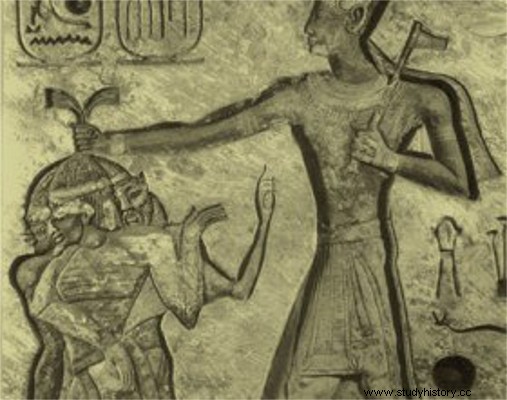
Egypt, located in the northeast region of the African continent, it was a civilization that flourished thanks to the fertility of its lands and the availability of water resources offered by the River Nile. The favorable living conditions in that region were responsible for the growth of the population that soon began to organize itself in several decentralized communities called nomos.
The growth of society along the Nile River eventually established, in 3500 BC, the creation of two kingdoms:Upper and Lower Egypt. During the reign of Menes, Pharaoh of Upper Egypt, a process of unification took place where he subordinated all the nomarchs of Egypt (supreme leaders of the nome) under his command. In this way, we have established the first period of the dynastic era of Egypt:the Old Kingdom, which goes from 3200 BC. until 2300 BC.
Under the pharaoh, Egypt became a centralized monarchy made up of subjects subordinate to the monarch's power. In this way, the Egyptians were obliged to work in the fields, buildings and works administered by the pharaoh's government. Political centralization was again and again questioned by the nomarchs. After a long period of stability, pressure from the nomarchs ended up decentralizing political power in 2200 BC.
In the latter part of the 21st century BC, Pharaoh Mentuhotep undertook a new process of political unification of Egypt. The capital was transferred to the city of Thebes and government centralization and the collective servitude system were reimplanted. After four centuries of stability and strengthening of Pharaonic power, there was an invasion promoted by the Hyksos, in 1630 BC. Counting on a better prepared military arsenal and using horses and war chariots, the Egyptians were subordinated to the presence of the Hyksos for two centuries.
In the middle of the 17th century BC, Amosis I managed to organize a mobilization of Egyptians against the predominance of the Hyksos. At the same time, the Egyptian people subordinated the Hebrews and expanded their territorial domains. Under Thutmose III (1480 BC – 1448 BC), the Egyptians conquered regions of Sudan and Mesopotamia. At that time, the power of the pharaonic authority reached its peak through the great availability of fertile lands, herds and workers.
In the government of Amenhotep IV (1377 BC - 1358 BC), the pharaoh imposed the destructuring of polytheistic religious practice in favor of the unique and exclusive worship of the god Aten, representative of the solar circle. Changing his name to Akhenaten, the pharaoh builds a new capital in honor of the sun god. After his death, the monotheistic practice was abolished by his son Tutankhamun. After experiencing a new process of territorial expansion, under the rule of Ramses II, Egypt underwent a new process of decentralization around 1100 BC.
The military weakening resulting from territorial separation made possible the invasion of the Assyrians in 662 BC. Reacting to the domination of the Assyrians, Psamtik I carried out a new process of centralization of the Egyptian government. This period, known as the Saite Renaissance, was marked by the broad development of trading practices among the Egyptians. Under Pharaoh Necao, he sponsored an expedition to circumnavigate the African continent.
In 525 BC, the Persians managed to conquer the Egyptians at a time when they were experiencing a period of instability, marked by several peasant revolts. In the following centuries, the Egyptians were subject to the domination of other different peoples. Influenced by the cultural diversity of its rulers, Egypt has become a region marked by intense cultural variability.
Take the opportunity to check out our video classes related to the subject:
